$C_{6}H_{12}O_{6} + 2ADP + 2P_{i} \rightarrow 2C_{3}H_{6}O_{3} + 2ATP + 2H_{2}O$
$C_{6}H_{12}O_{6} \rightarrow 2C_{2}H_{5}OH + 2CO_{2} + \text{Energy}$
The NCERT Exemplar Class 11 Biology Solutions Chapter 14 Respiration in Plants discusses aerobic and anaerobic respiration. It also includes how plants decompose food to release energy, a process important for their growth and development. Plants lack special respiratory organs that animals have, but plants release gases through stomata (leaves), lenticels (stems), and root hairs (roots). The NCERT Exemplar explains all other important basic factors, which lay a strong foundation in the subject of biology.
This Story also Contains
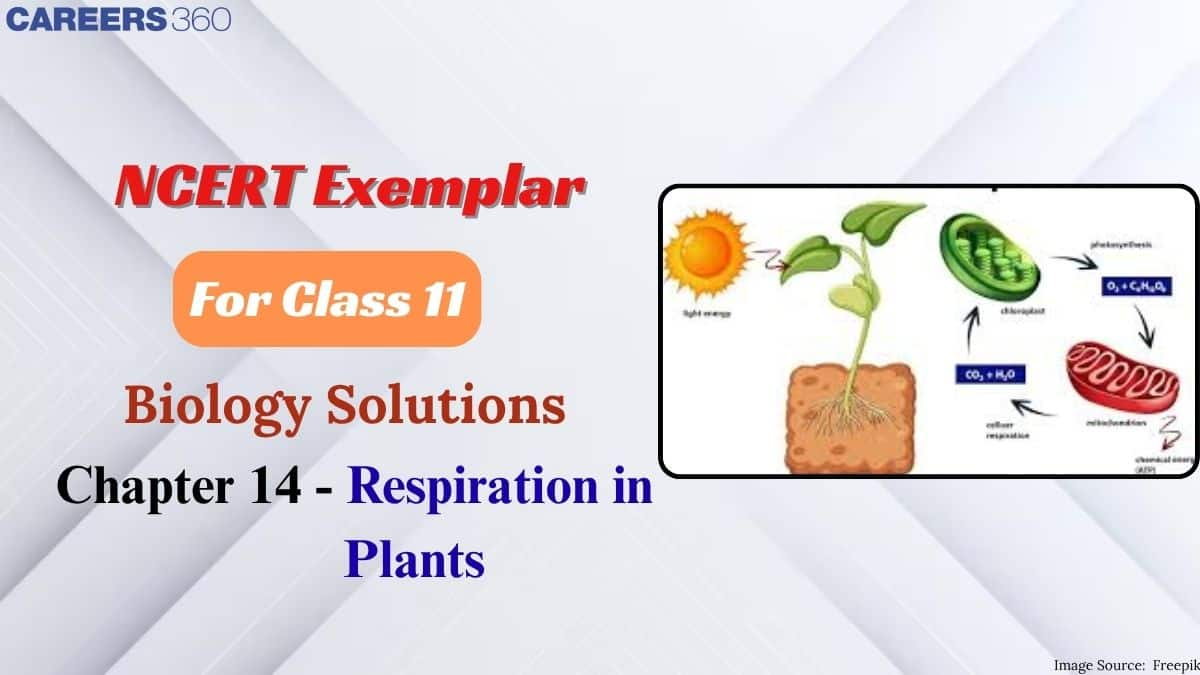
Respiration involves three main steps: glycolysis (in the cytoplasm), the Krebs cycle (in the mitochondria), and the Electron Transport Chain, which produces most of the ATP. Moreover, the chapter describes fermentation, a form of anaerobic respiration in certain plants that produces alcohol and carbon dioxide. Students also need to check the NCERT Solutions for Class 11 Biology for other chapters. Generally, plant respiration is vital as it supplies the energy required for different biological processes, such as growth, repair, and metabolism.
Question:1
The ultimate electron acceptor of respiration in an aerobic organism is
(a) cytochrome
(b) Oxygen
(c) hydrogen
(d) Glucose.
Answer:
The answer is option b) oxygen
Explanation: The electrons accepted by the oxygen molecules are the ones that are removed from hydrogen, which makes oxygen an electron acceptor.
Question:2
Phosphorylation of glucose during glycolysis is catalysed by
(a) phosphoglucomutase
(b) phosphoglucoisomerase
(c) hexokinase
(d) phosphorylase
Answer:
The answer is option c) hexokinase
Explanation: Hexokinase is responsible for the phosphorylation of glucose, which leads to the production of glucose-6-phosphate.
Question:3
Pyruvic acid, the key product of glycolysis, can have many metabolic fates. Under aerobic conditions, it forms
(a) lactic acid
(b) CO2 + H2O
(c) Acetyl CoA + CO2
(d) ethanol+ CO2
Answer:
The answer is option c) Acetyl CoA + CO2
Explanation: Acetyl CoA, CO2, and NADH are the products obtained when Pyruvic acid undergoes a dehydrogenation reaction.
Question:4
The Electron Transport System (ETS) is located in the mitochondria
(a) outer membrane
(b) intermembrane space
(c) inner membrane
(d) matrix.
Answer:
The answer is option (c) Inner membrane
Explanation: ETS is the electron transport system, which acts as carrier molecules that can act as electron acceptors as well as donors, and it is present in the inner membrane of mitochondria.
Question:5
Which of the following exhibits the highest rate of respiration?
(a) Growing shoot apex
(b) Germinating seed
(c) Root tip
(d) Leaf bud
Answer:
The answer is option (b) Germinating seed
Explanation: Germination is the process that has the maximum growth rate as compared to other options and has the highest respiration rate; hence, germinating a seed is the correct answer.
Question:6
Mitochondria are called the powerhouses of the cell. Which of the following observations supports this statement?
(a) Mitochondria synthesise ATP.
(b) Mitochondria have a double membrane.
(c) The enzymes of the Krebs cycle and the cytochromes are found in mitochondria.
(d) Mitochondria are found in almost all plant and animal cells.
Answer:
The answer is option (a) Mitochondria synthesise ATP
Explanation: Mitochondria, which synthesise ATP (Adenosine triphosphate) are called the powerhouse of the cell as ATP provides the energy to fuel many processes of the cell.
Question:7
The end product of oxidative phosphorylation is
(a) NADH
(b) Oxygen
(c) ADP
(d) ATP + H2O.
Answer:
The answer is option (d) ATP + H2O
Explanation: This process is mainly used for the oxidation of nutrients by the use of enzymes in order to release energy and molecular oxygen.
Question:8
Match the following and choose the correct option from those given below.
Column A | Column B |
A.Molecular oxygen | i. a-ketoglutaric acid |
B.Electron acceptor | ii. hydrogen acceptor |
C.Pyruvate dehydrogenase | iii. cytochrome c |
D.Decarboxylation | iv. Acetyl-CoA |
(a) A-ii, B-iii, C-iv, D-i
(b) A-iii, B-iv, C-ii, D-i
(c) A-ii, B-i, C-iii, D-iv
(d) A-iv, B-iii, C-i, D-ii
Answer:
The answer is the option (a) A – (ii), B – (iii), C – (iv), D – (i)
Question:1
Answer:
During the process of respiration, energy is released. This is the energy that gets stored inside the Mitochondria in the form of ATP molecules. Whenever our body needs energy, it is released from the Mitochondria in the form of ATP molecules, which are then broken down to release energy.
Question:2
Answer:
Energy currency means a reserve of energy that can be used as a currency to obtain something at the required times. ATP is called the energy currency as it acts as an energy source, which is released as and when our body requires it. It is present in plants as well as animals as an energy source.
Question:3
Answer:
a) The volume of carbon dioxide is indicated by A. The volume of oxygen consumed is indicated by B.
b) Respiratory quotient
= 1 (equal to 1), for carbohydrates
< 1 (Less than 1), for fats and proteins
> 1 (greater than 1), for organic acids
Question:4
F0 -F1 particles participate in the synthesis of
Answer:
ATP synthesis is the process in which F0−F1 particles participate.
Question:5
When does anaerobic respiration occur in man and yeast?
Answer:
In the case of yeast, when there is an unavailability of oxygen, anaerobic respiration takes place. However, in the case of man, the anaerobic process takes place in special cases. These include the situations of strenuous physical exercise in which muscle cells require a lot of extra energy.
Question:6
Which of the following will release more energy on oxidation? Arrange them in ascending order,
(a) Igmoffat
(b) 1 gm of protein
(c) 1 gm of glucose
(d) 0.5 g of protein + 0.5 g glucose
Answer:
(b) < (c) < (d) < (a)
As compared to all the elements in the options, 1 g of fat will release the highest amount of energy during the process of oxidation.
Question:7
Answer:
Carbon dioxide and water are the products of aerobic glycolysis in skeletal muscle, while ethanol and carbon dioxide are the products of anaerobic fermentation in yeast.
Question:1
Answer:
Glucose and fats both provide energy. However, glucose is a quicker and more instant source of energy than fats, as aerobic cellular respiration releases instant energy from glucose. This process creates CO2 and water as its by-products. Also, the absorption rate of glucose in our body is faster than fats. Hence, when a person is feeling dizzy, he or she should be given glucose at the earliest and a food product containing fats.
Question:2
What is meant by the statement “aerobic respiration is more efficient”?
Answer:
Unlike anaerobic respiration, the process of aerobic respiration leads to the complete oxidation of substances. This reaction releases energy and carbon dioxide. So, in the case of aerobic respiration, a larger amount of energy is produced as compared to the anaerobic respiration process as complete oxidation takes place. Hence, aerobic respiration is considered an efficient process.
Question:3
Answer:
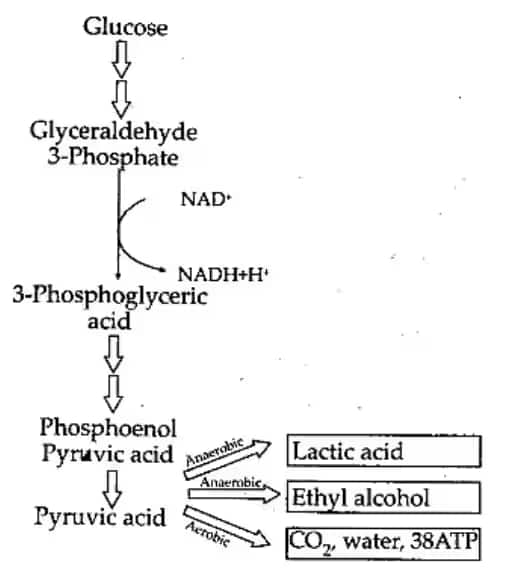
(a) Lactic acid
(b) Ethanol
(c) Acetyl CoA
Question:4
Answer:
Anaerobic respiration generally does not lead to the production of a higher amount of energy than the aerobic respiration process. But still, in certain circumstances, organisms do undergo anaerobic respiration in the absence of enough supply of oxygen.
$C_{6}H_{12}O_{6} + 2ADP + 2P_{i} \rightarrow 2C_{3}H_{6}O_{3} + 2ATP + 2H_{2}O$
Question:5
Answer:
The role of oxygen in the process of aerobic respiration is only at the end of the process. The vital importance of oxygen is that it drives the hydrogen out of the body by driving the whole process and acting as a final hydrogen acceptor.
Question:6
In this statement about respiration, explain the meaning of
(i) Step-wise oxidative breakdown
(ii)Organic substances (used as substrates)
Answer:
(i) Step-wise oxidative breakdown
The oxidation of an element does not happen in one single go. It happens in a step-by-step process known as a step-wise oxidative breakdown. The cells of our body also require some energy to perform other functions. This step-by-step release of energy would ensure proper utilisation of energy and make it large enough to be associated with the synthesis of ATP molecules.
ii) Organic Substances
Organic substances are the ones which are present in living organisms. These substances are oxidised in the process of respiration to release energy. Examples of organic substances are carbohydrates, proteins, and fats.
Question:7
Answer:
ATP molecules are also used in the process of respiration, which also involves energy production. It is used to fuel energy into the formation of some intermediaries during the respiration process. It is used two times in the process of respiration, which includes: the conversion of glucose into glucose 6-phosphate and the conversion of fructose 6-phosphate into fructose 1, 6-biphosphate. There is a gain of 36 ATP molecules when the oxidation of one molecule of glucose takes place. Hence, the net gain is higher than the consumption, and that is why we can label the respiration process as an energy-yielding process.
Question:8
Answer:
Step A: fructose 6-phosphate
Step B: fructose 1, 6-biphosphate
Step C: triose phosphate
Step D: triose biphosphate
And finally, in Step E, we can conclude that the energy is being used up.
Question:9
Why is the respiratory pathway referred to as an amphibolic pathway? Explain.
Answer:
Generally, the pathway of respiration is also called the catabolic pathway. This happens as it involves the release of energy by breaking down substances. Most of the time, organic substances like carbohydrates, proteins, and fats are converted into energy by breaking them down, but sometimes an intermediate product of this process, like Acetyl CoA, will be used by the body to synthesise proteins or fats again. Hence, the process of respiration is both a catabolic as well as an anabolic pathway.
Question:10
Answer:
The other energy carriers present in the cell include NADP (Nicotinamide adenine dinucleotide phosphate) and NADPH (Nicotinamide Adenine Dinucleotide Phosphate Hydrogen).
Question:11
ATP produced during glycolysis is a result of substrate-level phosphorylation. Explain.
Answer:
Substrate-level phosphorylation is the stage where the ATP formation happens by the transferring of the phosphoryl (PO3) group from a phosphorylated reactive intermediate to ADP. In the process of glycolysis, ATP formation happens at two main stages, which are as follows:
1) Conversion of BPGA (biphosphoglyceric acid) into PGA (phosphoglyceric acid).
2) Conversion of PEP (phosphoenolpyruvate) into pyruvic acid.
Question:12
Do you know any step in the TCA cycle where there is substrate-level phosphorylation? Which one?
Answer:
There is one stage in the citrus cycle where there is substrate-level Phosphorylation. It is the one where succinic acid is produced from succinyl-CoA. So, it leads to a conversion of the GTP (Guanosine triphosphate) molecule to the GDP molecule.
Question:13
In a way, green plants and cyanobacteria have synthesised all the food on the Earth. Comment.
Answer:
The statement that green plants and cyanobacteria have synthesised all the food on the Earth is quite true and can be justified as follows. Since the major producers in the aquatic environment are cyanobacteria and the major producers for terrestrial organisms are plants, all the other organisms are dependent in a direct or indirect manner on these producers.
Question:14
Answer:
The advantages of stepwise energy release in oxidation are:
- Prevention of all the energy being used up in one go
- Stored energy reserves in the form of ATP can also be used in the future
- The making of intermediary products also requires energy
- The stored energy can also be used in other processes in the body
Question:15
Answer:
According to the scientists, the category of cells that were found on Earth was anaerobes. These cells carried out anaerobic respiration and did not require a continuous supply of oxygen for this process. Also, under special situations, all organisms can respire in an anaerobic manner and partially oxidise the glucose. Owing to this ability, the cells may have survived the atmosphere without oxygen.
Question:16
Answer:
The reasons that red muscle fibres in animals can work continuously for longer periods are:
- They are thin muscle fibres
- They get plenty of oxygen supply due to the high amount of myoglobin
- Lactic acid is not formed here, as they resort to aerobic respiration
- The number of mitochondria is high in number and hence has a good supply of energy through ATP molecules
Question:17
Answer:
In the case of aerobic respiration, the oxidation of glucose happens completely, which leads to a net gain of 36 ATP molecules for one glucose molecule. While in anaerobic respiration, the oxidation of glucose does not happen in a complete manner, and the number of ATP molecules produced is just 2 for one molecule of glucose.
Question:18
RuBP carboxylase, PEPcase, Pyruvate dehydrogenase, ATPase, Cytochrome oxidase, Hexokinase, Lactate dehydrogenase. Select/ choose enzymes from the list above that are involved in
(a) Photosynthesis
(b) Respiration
(c) Both in photosynthesis and respiration
Answer:
(a) enzymes involved in photosynthesis are: RuBP carboxylase, PEPcase
(b) Enzymes involved in respiration are: Pyruvate dehydrogenase, Hexokinase, Lactate dehydrogenase
(c) enzymes involved in photosynthesis as well as respiration, are ATPase, cytochrome oxidase
Question:19
How does a tree trunk exchange gases with the environment, although it lacks stomata?
Answer:
The tree trunk does not have stomata like the green leaves. But it is covered with a wooden bark that contains lenticels. These lenticels facilitate the exchange of gases in the case of tree trunks.
Question:20
Write two energy-yielding reactions of glycolysis.
Answer:
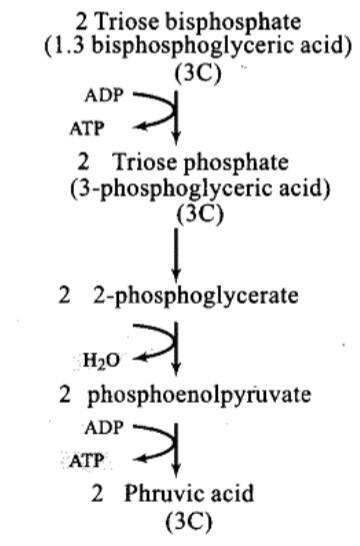
The two reactions in glycolysis that yield energy are:
(a) Formation of PGA (phosphoglyceric acid) from BPGA (biphosphoglyceric acid)
(b) Formation of Pyruvic acid (phosphoenolpyruvate) from PEP
Question:21
Answer:
The main site for the formation of pyruvate is the cytoplasm of a cell. Pyruvic acid dehydrogenase acts as a catalyst in the decarboxylation of pyruvate, as shown below:

The reaction of decarboxylation of pyruvate produces Acetyl CoA as a by-product.
Question:22
Answer:
The important series of events of aerobic respiration that occur in the mitochondria are as follows:
a) The matrix of mitochondria
Complete oxidation of pyruvate. This oxidation is a step-by-step procedure. It involves the elimination of all the atoms of hydrogen, leaving behind three molecules of CO2.
The inner membrane of the mitochondrion.
Oxygen acts as an electron acceptor here. As the hydrogen atoms are passed to the oxygen atoms, the removal of electrons takes place along with the formation of ATP molecules.
Question:23
Answer:
The citrus cycle involves the breakdown of glucose molecules, depicting catabolic behaviour. And it also involves the formation of FADH2 and ATP molecules, which depict its anabolic behaviour. Hence, both these process takes place in the TCA cycle, and this is the reason because of why it can be labelled as amphibolic.
Question:1
Answer:
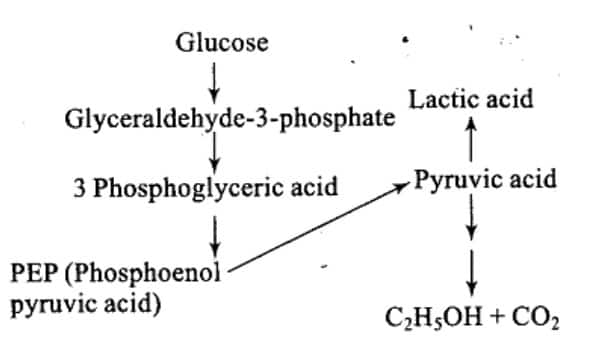
The major pathways or the sequence of the steps are shown in the image above. The left flowchart depicts the process of glycolysis. The right flow chart depicts the processing of pyruvic acid, which then leads to the formation of lactic acid. In some organisms, to produce CO2 and ethanol, pyruvic acid is processed to release some amount of energy. The applications of anaerobic respiration are:
- To bring the rise in bread and cakes and make them fluffy, the yeast undergoes anaerobic reproduction.
- In the formation of curd, when he inoculum is lactobacillus
Question:2
F1, Particle, Pi, 2H+, Inner mitochondrial membrane, ATP, F0 particle, ADP.
Answer:
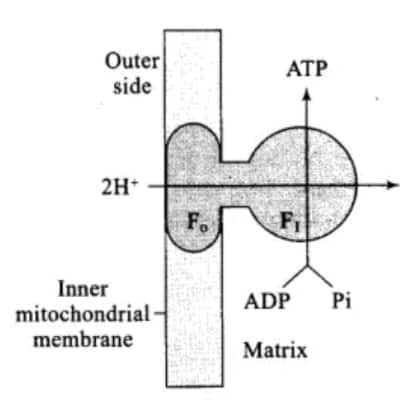
Question:3
Oxygen is critical for aerobic respiration. Explain its role with respect to ETS.
Answer:
NADH+, H+, and FADH2 are the carriers of energy in the electron transport system. These carriers are utilised to produce ATP during this process. Oxygen molecules accept electrons which are transferred to them through a series of reactions. Oxygen molecules accept the hydrogen molecules and lead to the formation of water molecules. This process is important for the aerobic respiration process.
The process of Oxidative phosphorylation involves the transfer of electrons, which can be related to the flow of water through a tap. Just as in that case, the droplets cannot flow down until the first drop is allowed to pass through, after the first electron is allowed, others follow when the oxygen starts accepting electrons as a hydrogen acceptor. That is the reason due to which the presence of oxygen is necessary for the electron transfer to be made possible by the creation of a gradient.
Question:4
Answer:
The assumptions that are made during the calculation of a respiratory balance sheet are:
- An orderly and sequential pathway is followed in the process of respiration.
- During the process of glycolysis, NADH is produced. This undergoes oxidative phosphorylation inside the mitochondria.
- No intermediate products are utilised in the formation of other products
- Glucose is oxidised only, and no other substance is utilised at any in-between stages. The above assumptions are invalid for a living organism. The processes need to take place simultaneously and not follow a strict sequential path.
Fermentation | Aerobic respiration |
Glucose gets converted to ethanol during its partial breakdown. | Glucose breaks down completely, which leads to the formation of carbon dioxide. |
Gain of ATP molecules: 2 | Gain of ATP molecules: 36 |
3slow oxidation process of NADH to NAD+ | Fast oxidation process of NADH to NAD+ |
Question:5
Answer:
Pyruvic acid is formed in the process of glycolysis due to the breakdown of glucose, which takes place in the cytoplasm of the cell. This process also involves the partial oxidation of glucose molecules, known as the EMP pathway. The important steps involved in the process of glycolysis are as follows:
- Phosphorylation of glucose for the production of glucose-6-phosphate
- Formation of PGAL (Phosphoglyceraldehyde) through the conversion of Fructose-6-phosphate
- The molecules of PGAL are further processed for the production of Pyruvic acid.
- Two molecules of ATP are gained in the process of glycolysis of one glucose molecule
Aerobic Respiration of Pyruvate:
Complete oxidation of Pyruvic acid takes place, and carbon dioxide and Energy are produced as a result of this reaction.
Anaerobic Respiration Pyruvate:
In the absence of oxygen, Anaerobic Respiration takes place, and ethanol and CO2 are produced from the conversion of pyruvic acid. In some organisms that face a complete absence of oxygen, the pyruvic acid can also be converted to lactic acid.
Also, check NCERT Books and NCERT Syllabus here
The candidates can begin by thoroughly understanding the key concepts, such as glycolysis, the TCA cycle, and the electron transport system, focusing on the steps, locations, and ATP yield. They can use diagrams and flow charts in their answers to present them clearly. They should include scientific terms such as oxidative phosphorylation and substrate-level phosphorylation to show conceptual accuracy. The answers can be structured in well-organised points or short paragraphs with appropriate headings. They should revise the NCERT content line by line, as questions are mostly based on the textbook wording.
Also, read the NCERT Solution subject-wise
This chapter explores many important topics, such as how plants break down food molecules to release energy, and the steps and pathways involved in the process.
Introduction to Cellular Respiration
Glycolysis (EMP Pathway)
Fermentation (Anaerobic Respiration)
Aerobic Respiration and Its Stages
Krebs Cycle (Citric Acid Cycle/TCA Cycle)
Electron Transport System (ETS) and Oxidative Phosphorylation
Respiratory Quotient (RQ)
Energy Yield and ATP Calculation
Amphibolic Pathway and Respiratory Substrates
NCERT Exemplar Class 11 Solutions:
The chapter Respiration in Plants explains how plants break down glucose to release energy through different steps, including glycolysis, the Krebs' cycle. Solving exemplar problems offers many advantages to students, some of which are mentioned below:
This part includes an important question that helps you understand how plants get energy through different steps of respiration.
Question 1. Which one of the following metabolites moves from mitochondria to peroxisomes during the operation of the C2 oxidative photosynthetic cycle?
Options:
Glycerate
Glycolate
Glycine
Serine
Answer: The correct answer is option (B), Glycolate
Explanation: In the C2 oxidative photosynthetic cycle, also known as the photorespiratory pathway, glycolate is produced in the chloroplasts during the oxygenation of Ribulose-1,5-bisphosphate (RuBP) by the enzyme Rubisco. Glycolate is then transported out of the chloroplasts and enters the peroxisome. The peroxisome plays a crucial role in these reactions, where the metabolite glycolate is initially transported from the mitochondria to the peroxisome for further processing.
Must Read NCERT Notes subject-wise
The biology chapter-wise exemplar solutions of Class 11 are given below:
Frequently Asked Questions (FAQs)
Yes, one can understand the answering style and can also revise the topics from the solutions.
Glycolysis of plant respiration takes place in the cytoplasm, wherein glucose is disintegrated into two molecules of pyruvate. The process produces ATP and NADH without needing oxygen. The process consists of a series of enzyme-catalyzed steps that transform glucose into energy intermediates. The resulting pyruvate flows into the mitochondria for more respiration in case oxygen is present.
The Krebs cycle, which takes place in the mitochondria, plays a significant role in plant respiration because it produces ATP, NADH, and FADH₂ for the generation of energy. It also releases CO₂ as a waste product and offers intermediates for biosynthesis. The generated NADH and FADH₂ power the electron transport chain for additional ATP. The Krebs cycle facilitates the effective release of energy from organic molecules.
The electron transport chain (ETC) in plant respiration takes place in the inner mitochondrial membrane, with electrons from NADH and FADH₂ being passed via protein complexes. This moves protons into the intermembrane space, establishing a proton gradient. The proton return via ATP synthase forces the creation of ATP. Oxygen acts as the terminal electron acceptor to give water.
The major steps in plant respiration are:
Glycolysis – Glucose is broken down into pyruvate in the cytoplasm, producing ATP and NADH.
Krebs Cycle – Pyruvate is further oxidized in the mitochondria, releasing CO₂, ATP, NADH, and FADH₂.
Electron Transport Chain (ETC) – NADH and FADH₂ donate electrons to generate ATP, with oxygen acting as the final electron acceptor.
Fermentation is oxygen-free and results in ATP with byproducts such as ethanol or lactic acid. Aerobic respiration is an oxygen-requiring process and produces much more ATP by completely oxidizing glucose to CO₂ and H₂O. Fermentation takes place in the cytoplasm, whereas aerobic respiration goes on in the mitochondria. Aerobic respiration is more efficient in terms of energy compared to fermentation.
ATP is the primary energy carrier in plant cellular respiration, storing and transferring energy for cellular processes. It is produced during glycolysis, the Krebs cycle, and oxidative phosphorylation. ATP powers essential functions like nutrient transport, biosynthesis, and growth. It is continuously regenerated to sustain metabolic activities in plant cells.
As per latest syllabus. Physics formulas, equations, & laws of class 11 & 12th chapters
As per latest syllabus. Chemistry formulas, equations, & laws of class 11 & 12th chapters
As per latest 2024 syllabus. Study 40% syllabus and score upto 100% marks in JEE
As per latest syllabus. Maths formulas, equations, & theorems of class 11 & 12th chapters